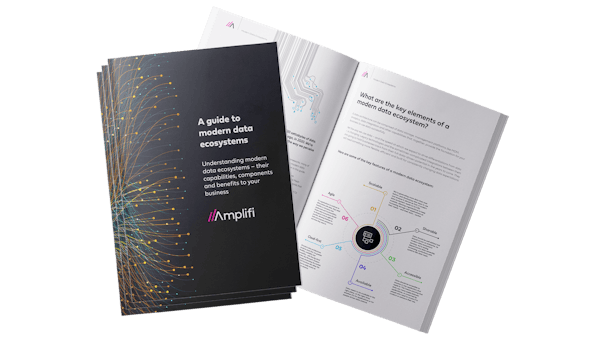The anatomy of a modern data ecosystem
As mentioned above, precisely defining a modern data ecosystem is impossible. It will never be finished: there will always be a new innovation, a new software, a new function that can be added to further modernise any ecosystem, and part of the process is understanding those changes and your own changing needs as a business. However, as a collection of data-related capabilities, there are certain elements that can and should be embedded in a ‘modern data ecosystem’ today.
The following isn’t a comprehensive list, but breaks down some of the core elements that a data ecosystem today should include:
Core infrastructure
The platform that underpins your architecture, usually cloud-based for modern data architectures.
Ingestion
The pipelines that import your data from multiple sources into your data storage.
Data storage
Whether it’s a Data Lake, Warehouse, Lakehouse, or several strategically placed data stores, this layer stores your data, ready to be accessed.
Data integration and virtualisation
This is the technology that enables consistent access to and delivery of data to where it’s needed: a critical part of a functioning data ecosystem.
Data access layer
This makes your data available to those who need it, including for operational reporting, APIs, Data science, AI, Machine Learning, and operational reporting.
Data Governance and management
Your governance and management ensure that data, including metadata, is accurate, available reliable, secure, and recoverable. It also governs change control and serviceability, so that your stack can continuously and seamlessly evolve with your needs – a core principle of any modern data ecosystem.
Data Catalogue and Enterprise Knowledge graph
The Data Catalogue creates an organised inventory of data assets in your organisation, using metadata to help you manage your data, enabling better context, control, and collaboration. The enterprise knowledge graph relates the underlying data to real world concepts and relationships.
Active Metadata
Truly modern data ecosystems treat metadata as a critical asset, continually monitoring and observing all aspects of it. By applying advanced analytic techniques over this metadata, the ecosystem is able to inform its own evolution.
Data security
Security is fundamental to any data architecture: with cyber threats growing, ensuring that security is built into your architecture is essential: including data masking, encryption, data erasure, and data resilience.
Modern Business Intelligence (BI) and analytics platforms
Analytics capabilities should be available to multiple personas across the organisation, incorporating augmented analytics and support for decision intelligence.
Data Science and Machine Learning platforms
Data science and machine learning delivers business value by supporting the democratisation of these functions across the organisation, as well as decision intelligence, allowing all departments to extract value and insight from data.
Culture
Culture is important to any data initiative’s success, but when it comes to creating a modern data ecosystem, it’s even more essential. Successful modern data ecosystems hinge on how different aspects of the architecture are used and integrated together: making this work means having robust governance procedures throughout the business, ensuring that everyone understands their relationship to data and the importance of maintaining and utilising the architecture effectively.





